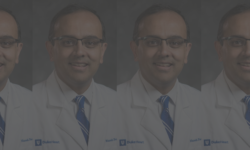
In 1961, undergraduate sophomore Joseph Alpert was hired as a lab technician at Bingham Oceanographic Laboratory at Yale University. As a prospective English major, he was merely looking for a job, and he would find himself spending his days distinguishing the various species of deep sea fish that had been “dredged up” by various world expeditions.
Alpert’s lab was working with a group of deep-sea fish called the Evermannella, a genus of sabertooth fish with glossy, pale eyes and recurved teeth similar to those of saber-toothed cats. He worked under the direction of Dr. Alfred Ebeling, a Ph.D. from Scripps Oceanographic Lab in La Jolla, California.
Alpert was deeply intrigued by his ichthyology studies, and Ebeling would ultimately urge him to pursue a PhD in ichthyology. At that point, Alpert was at a pivotal crossroad in his life, torn between a life of research and a life of medicine — after all, he had already applied and gotten accepted into medical schools at Yale, Johns Hopkins, and Harvard.
“I always thought I was gonna go to medical school, and follow my father, who was a busy and excellent clinician,” Alpert remarked.
The early years
Joseph Alpert grew up in New Haven, Connecticut: being in such close proximity to Yale University, he aspired to apply to and ultimately attended the prestigious university.
Alpert’s father was also a New Haven native and owned a large dental practice, and it was expected that Alpert would take over the business after attending dental school one day. His mother was a high school English teacher who had previously been a journalist.
Alpert went off to college thinking that he’d probably be a pre-medical student, and Yale only required four courses for pre-meds: basic chemistry, organic chemistry, physics, and biology. So, Alpert enrolled in a variety of other humanities courses – history, psychology, and English – and thoroughly enjoyed them all.
“But my father used to always joke, ‘What’s your major this week?’” Alpert chuckled.
Alpert’s senior year was spent participating in Yale’s Scholars of the House program, a program that allowed six to 12 seniors to devote an entire year to an interdisciplinary project of their choice. Though the program has since discontinued, it provided a spectacular opportunity for Alpert to explore ichthyology on his own terms, rather than taking classes for credit.
His project focused on Siamese fighting fish, better known as the betta fish, which are commonly kept as household pets due to their low maintenance and vibrant colors. Alpert performed a series of experiments that involved raising them in different oxygen levels, observing differences in the development of the breathing apparatus of the fish.
“They come from Southeast Asia,” Alpert explained. “During the dry season, these fish actually breathe air. During long summer months in Thailand and Cambodia, these ponds almost dry up, and the heat is intense. So this adaptation enables them to ‘air breathe.’”
The Denmark era
“I have a good friend in Denmark, and the Danes’ collection of deep sea fish is the best in the world,” Ebeling told Alpert, who eventually sought his mentor’s assistance with deciding between ichthyology and medical school.
Denmark truly was, and still is, the hub of fish studies. The Natural History Museum of Denmark currently holds about a third of the 35,000 known species of fish. Dating some 250 years back in time, the museum boasts approximately 250,000 specimens in its digital registry. According to Alpert, many of the most prominent deep sea fish discoveries came out of a Danish research ship called the Dana: researchers on board would throw a net down to 1000 feet and preserve the specimens caught in the net with alcohol or formaldehyde solution.
With Ebeling’s suggestion in mind, Alpert ultimately applied for the Fulbright Program, a competitive program that provides grants and scholarships to graduate students, young professionals, and artists to study, teach, or conduct research abroad. He was accepted, which allowed him to travel to Denmark to further pursue ichthyology research.
“They put us in a half sorority, half fraternity dorm,” Alpert said. “They use it as a hotel in the summer to make money, so it’s subsidized to the students and very inexpensive to live there.”
Between taking courses, working on his own research project, and becoming close friends with the other students in his dorm, Alpert also met a woman who would eventually become his first wife.
“Denmark changed my life,” Alpert said. “But I eventually had a hard time imagining myself sitting in the lab all day looking through a dissecting scope and counting fin rays for 50 years. So, I ended up deciding to go to medical school.”
Of course, Alpert had no idea what medical school was going to be like, even though he had watched his father for twenty-something years of his life and seen his commitment to his patients.
All he really knew was that, after graduating medical school, he’d be a doctor and get a nice, white coat.
The transition to cardiology
After his year in Denmark concluded, Alpert began his studies at Harvard Medical School. He found himself enjoying a life of academia, tracing his interest in research and science back to his beloved mentor Ebeling, who went on to build a very distinguished career as an ichthyologist.
During his time abroad, Alpert had become friends with one of the Danish medical students, whose uncle was head of a department at Bispebjerg Hospital, one of the major Copenhagen University teaching hospitals. So, he ended up doing a summer research project with Niels Lassen, one of the world’s premier circulatory physiologists at the time.
“You took radioactive xenon, it’s dissolved in saline, and you can inject it into muscles or flush it into the kidney or the brain, and you can determine the blood flow,” Alpert said.
Alpert’s task was to look at patients with intermittent claudication – leg muscle pains occurring due to poor blood flow – with peripheral vascular disease – a blood circulation disorder affecting the blood vessels outside of the brain and heart. He sought to uncover the blood flow patterns in affected patients and find the causes of interrupted circulation.
“[Niels] showed me the test, and I ran it on myself,” he said. “It was very simple: you strapped a little scintillation detector to the gastrocnemius – the calf muscle – and you followed the curve. And then you could calculate blood flow from that.”
And when Alpert wondered where he could possibly find volunteers to conduct the tests on, Lassen simply replied, “You get down there and you tell them, ‘We have a little test for you… and there’s two free beers if you come and do it!’”
Of course, all of his research took place before human subjects committees were established to protect the rights and well-being of human research subjects.
“It was in a very different era from now,” Alpert laughed.
Alpert and Lassen published a study in circulation, and Alpert would return to Copenhagen the following year to write even more papers. His experience with Lassen “absolutely solidified” that he would stay in academia, and that he would specialize in cardiovascular disorders.
During his third year at Harvard, Alpert spent the whole year doing clinical work: three mince of medicine, three months of surgery, six weeks of OB, six weeks of pediatrics, and so forth.
“Life is filled with fortuitous events,” Alpert added. “The attending for the first month I was there was Louis Dexter, who was one of the pioneer cardiologists of the 20th century and became a whisker of winning the Nobel Prize.”
Life after Harvard
Following medical school, Alpert served two years in the San Diego Naval Hospital, due to the legalized U.S. military draft in the mid-1900s. He was in charge of their coronary care unit, and his work ultimately reoriented his career to taking care of patients specifically with myocardial infarction – heart attacks.
Then, he returned to Brigham and Women’s hospital in Boston to run their coronary care unit, until Jim Dalen, who was a member of Dexter’s lab, asked him to become the Chief of Cardiology at UMass Memorial Medical Center in Worcester, Massachusetts.
After 14 years at UMass, Dalen accepted a job as the dean of the University of Arizona College of Medicine; shortly after, Alpert accompanied him in Tucson as the Chief of Medicine for another 14 years.
Following the path of most Chiefs of Medicine, he served as the assistant dean for a couple years. However, he found the job to be unpleasant and unlikable, compared to cardiology and patient care.
“I was having lunch with the head of cardiology, Gordon Navy, who is one of the originators of the new CPR,” Alpert said. “He said, ‘Come back to cardiology and do your usual. Do what you’ve been doing for 40 years.’”
So, Alpert stepped down to become the head of the coronary care unit, and he’s been doing that ever since – pure cardiology, consulting patients with heart disease, and seeing outpatients.
Additionally, he had previously been the editor of a variety of smaller journals, such as Current Cardiology Reports and Cardiology in Review. As the author of 650 publications, more than 400 book chapters, review articles, and editorials, and 48 books and monographs, he was eventually offered the role of Editor-in-Chief of the American Journal of Medicine in 2005.
“I always published a lot,” Alpert said. “I always wrote a lot of things, partly because of the skills imparted to me by my former journalist mother. She always pushed us to write well and speak well.”
Exercise and health
“My patients say to me, ‘You’re not going to retire, are you?’” Alpert said. “I say my answer is, I’ll retire when I die!”
Looking towards the future, Alpert said that he enjoys his work, and that he doesn’t mind being busy. With all of his years of experience, he said that he is good for his patients and good for his trainees.
When asked about his future goals and plans, Alpert said that he wants to stay healthy and keep doing what he’s done for the past 50 years. His motto is “exercise on the days that you eat,” and he makes sure that he does an hour on his stationary bike in a gym room in his house. He also encourages his patients to lead a healthy lifestyle to lower their cholesterol and control their blood pressure.
He hopes to continue traveling nationally and internationally with his current wife, who studies myocardial ischemia, disruption of blood flow to the heart due to plaque buildup in a coronary artery. They have plans to travel around Iceland and Barcelona this summer.
“When we do our annual report, they say, ‘What are your goals for next year?’” Alpert said. “My goal is to keep going, at exactly the same speed, and do the same things I’m doing.”





